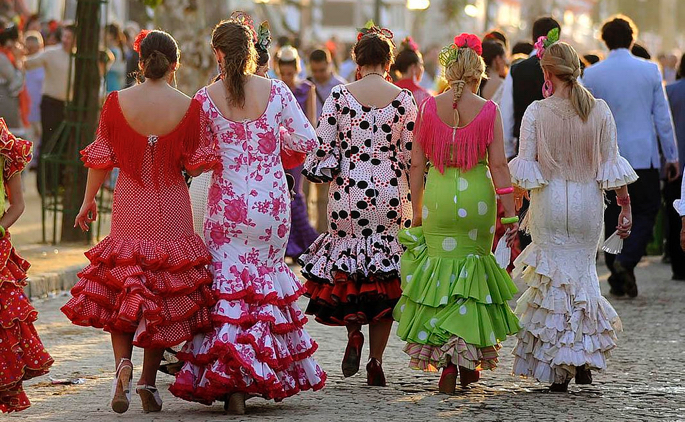Sevillanas is a popular song and dance form that has been folded into the repertoire of many practicing flamencos. Sevillanas are often perfomed at fairs and festivals, the most notable of which is the Feria de Abril in Sevilla.
Sevillanas music and dance is typically lively and upbeat and is performed either by a single dancer or a couple. Though some flamenco purists argue that Sevillanas is a folk dance (and therefore not “flamenco proper”) it incorporates many of the steps and techniques of traditional flamenco forms and is often the first form aspiring flamenco dancers learn.
Sevillana also has a very stable, formulaic structure which takes a lot of the complexity out of accompaniment and playing with other musicians.
Structure and Compas
The basic sevillana has three pre-defined sections:
- a rhythmic introduction
- a salida (a melodic “departure”)
- a three part copla (containing three related verse or melody sections).
Sevillanas can be counted in 3’s throughout with the accented beat on the 1 count:
1 2 3 1 2 3
Sevillanas are typically performed in sets of four. Though each composition in the set has a distinct theme, and is often in a different key, when done correctly each of the four parts works together to express a cohesive musical idea.
Check out the Sevillanas Accompaniment tab here on Ravenna Flamenco for a bar-by-bar explanation of Sevillanas structure.
Basic Sevillana Form
This basic sevillana in C major demonstrates the timing, rhythm, and parts of the sevillanas form. This particular sevillanas is adapted from a Sabicas recording and makes heavy use of an alzapua (thumb stroke) ligado technique on the trebel strings to create a cascading triplet melody. Download the tab for this sevillanas here.
Sevillanas Stylistic Variations
Though the sevillanas style is perhaps most strongly associated with dance accompaniment, it nonetheless offers a wide range of expressive possibilities for guitarists.
Paco de Lucia: “El Cobre”
Paco de Lucia’s “El Cobre,” recorded on the 1976 album Almoraima, is an (unsurprisingly) brilliant example of how musically interesting this form can be, even when strictly adhering to its rigid song structure:
Pedro Soler’s “Campos de Sevilla”
The playing on Pedro Soler’s 2004 album Luna Negra is earthy, intimate, and accessible, and his sevillanas “Campos de Sevilla” is no exception. Where many newer recordings of sevillanas are heavily layered with accompanying instuments or percussion, this track is just a single, soulful guitar—and is recorded in such a way that it sounds like Soler is right there in the room with you.
If you would like to learn the second and third sevillanas in this set, check out the Pedro Soler tablature transcriptions here on Ravenna Flamenco.
Accompanying Dancers
Sevillanas is an excellent form with which to begin accompanying dancers. Its structure is predetermined, so you won’t need to coordinate an arrangement, and it’s often the first form many flamenco dancers learn, which makes finding folks to accompany much easier. Sevillanas is also the kind of form beginners can throw together at party and still have a good time (as long as everyone knows the basics, that is).
To learn the individual parts of sevillanas dance accompaniment in detail check out the Sevillanas Accompaniment article here on Ravenna Flamenco. You’ll find tab, a video demonstration, and a step-by-step explanation of sevillanas structure and flow.
Also be sure to check out Ravenna Flamenco’s free selection of Sevillanas Tabs, which can help you build your repertoire and get started creating your own sevillanas sets.

